PDF Attached includes updated US supply and demand estimates, including summer 2021 quarter.
The
U.S. Federal Reserve kept its benchmark interest rate unchanged of near zero. They cited growing concerns over inflation and rising cases of the Delta Covid-19 variant. ICE Chat- US Fed Funds Futures Show Market Fully Pricing In 25bp Tightening By March 2023
![]()
Weather
– severe weather risk upper US WCB
WORLD
WEATHER INC.
MOST
IMPORTANT WEATHER OF THE DAY
- Additional
flooding occurred east-central China Tuesday from the remnants of Tropical Storm In-Fa - Rainfall
since last Friday has ranged from 12.75 to more than 22.00 inches in central and southern Jiangsu, southeastern Anhui and northern Zhejiang - One
location in southeastern Anhui reported 36.14 inches of rain in five days - China’s
flooding in Hebei and Henan from last week should be abating, but some rain coming to the region will aggravate the improving trend - China
is unlikely to see much more excessive rain once remnants of Tropical Storm In-Fa abates from the nation - The
storm’s greatest rain will pass through Shandong and northern Jiangsu today before turning to the northeastern provinces later this week - Rainfall
in these areas will not likely be quite as great as that of east-central China, but some local flooding is expected - Portions
of northern and eastern India will also be vulnerable to flooding in this coming week as a monsoon depression bring additional torrential rain to parts of the region - Rain
in northern India varied up to 4.30 inches Wednesday with central Uttar Pradesh wettest - Southern
India will continue to dry down over the coming two weeks - Far
northwestern Rajasthan and southern Pakistan will also remain too dry over the same period of time - Additional
torrential rain fell in northwestern Luzon Island, Philippines Tuesday with 4.00 to nearly 10.00 inches resulting in areas that received excessive rain during the weekend - Europe
rain will fall frequently, but lightly during the next ten days - Too
much moisture will threaten the quality of unharvested small grains and late winter rapeseed - Rain
intensity will not be as great as that of earlier this month, but still enough to raise concern over unharvested crop quality and to induce new delays to fieldwork - Southeastern
Europe still needs a boost in soil moisture, despite some beneficial rain that fell earlier this month - Showers
are expected in Romania and western Ukraine, but not enough will occur from Hungary to Greece to replenish soil moisture - Heavy
rainfall and strong thunderstorms will return to the Alps late this week through all of next week raising the potential for river flooding in parts of Germany and Italy - Canada’s
Prairies will continue dry biased except in northern and western Alberta where periodic rain will continue - Temperatures
were hot in the central Prairies Tuesday with highs in the 90s and extremes of 100 to 104 Fahrenheit - The
heat is temporarily abating, but more is expected in Alberta and western Saskatchewan late this weekend into early next week - In
the meantime, nighttime temperatures may slip to the 40s and 50s in some eastern Prairies locations in the next few nights as cooler air presses into the region - Excessive
heat occurred in the northern U.S. Plains Tuesday - Extreme
highs of 105 to 111 Fahrenheit occurred from western South Dakota into eastern Montana
- Hot
air from the northern Plains and Canada Tuesday will shift to South Dakota and southwestern Minnesota along with northwestern Iowa today with highs in the range of 95 to 105 common and a few hotter readings in South Dakota - Most
of the heat will retreat to the central Plains and southwestern Corn Belt Thursday before completely abating for a while - Alberta
and western Saskatchewan, Canada will begin heating up again during the late weekend and it may persist through much of next week - Cooling
is expected in the heart of the U.S. Midwest late this week into next week - Temperatures
will fall well below normal in a part of the region for a little while slowing crop development and conserving soil moisture - This
region will see a more prolonged period of cool weather in the second half of August
- Rain
in the central and eastern Midwest will fall sufficiently and often enough to maintain a very good production outlook through August - U.S.
Delta and southeastern states along with the Blacklands of Texas will see a good mix of weather for the next two weeks supporting most crop needs - South
Texas early harvesting of cotton, sorghum and corn should advance relatively well over the next week, but some rain could evolve late next week and on into the second week of August - Support
for tropical cyclone evolution remains high in the eastern Pacific Ocean over the next week to ten days - Some
of this higher potential for tropical cyclone activity is expected to move into the Caribbean Sea and Gulf of Mexico during the second week of the two week outlook before shifting into the Atlantic Ocean near mid-month and beyond - Recent
surface ocean cooling has begun in the tropical Atlantic and if this continues the tropical cyclone season this year may be less than previously expected - U.S.
western Corn Belt dryness is not expected to expand dramatically, but there will be some expansion into Iowa and Nebraska as time moves along over the next few weeks - Southeastern
Canada corn, soybean and wheat production areas continue to experience a favorable mix of weather - Wheat
areas would benefit from an extended period of dry weather to support the best harvest conditions - Australia
weather will be favorably mixed for canola, wheat and barley - Crops
have established well in most of the nation - Queensland
and northern New South Wales need more rain - Most
CIS crop areas will see a good mix of weather during the next couple of weeks - However,
dryness will remain in parts of Russia’s Southern Region and areas east northeast through Kazakhstan - Ukraine
soil and crop conditions should remain favorably rated, although some increase in rainfall may be needed in parts of the region - Ethiopia
rainfall has been sufficient to support coffee and other crops recently, but Uganda and Kenya rainfall has been light - The
pattern will continue for a while longer - West-central
Africa rainfall has diminished seasonably for a while - Rain
will be needed in Ghana and Ivory Coast soon - Recent
rain in southeastern Asia has been good for bolstering soil moisture and improving crop conditions in Laos, parts of Cambodia, eastern Thailand and western Myanmar - Indonesia
rainfall has decreased, but should be increasing again soon - South
Africa weather is expected to be dry for a while, but recent rain has western wheat and barley crops well established - A
boost in rainfall is needed in unirrigated eastern wheat production areas - Argentina
needs rain in its western wheat production areas, although cold weather has the crop dormant or semi-dormant right now leaving the need for a moisture boost to a time later in August and September prior to aggressive spring crop development - Showers
will evolve in a few southern Brazil crop areas today followed by colder weather - Frost
and some freezes are expected in coffee production areas of Sul de Minas, Brazil Friday and Saturday - Most
low temperatures will be zero to +4 Celsius (32-40F) with a few readings as cold as -2 in the traditionally coldest areas of the region - Western
coffee areas will only experience some patches of light frost - Sugarcane
and citrus in Brazil are not likely to be seriously impacted by frost and freezes Friday or Saturday, but some vegetative development will be negatively impacted due to soft frost - No
blossom bud damage is expected in citrus areas and leaf mass damage on the cane will not kill the crop, but it will set back its growth rates for a while - Southern
Oscillation Index has reached +16.10 and it is peaking after a strong rising trend since June 22 when the index was -3.36 - Mexico
weather has improved with increased rainfall in the south and west parts of the nation - Drought
conditions are waning, and crops are performing better - Dryness
remains in Chihuahua and northeastern parts of the nation - Weather
over the next ten days will offer some relief, but more rain will be needed in the drier areas - Central
America rainfall has been plentiful and will remain that way - Both
Honduras and Nicaragua have received frequent bouts of rain this month easing long term dryness, but more may be needed in some locations - Flooding
rainfall occurred in a part of the region from southern Nicaragua into Panama during the weekend - New
Zealand rainfall during the coming week will be near to above normal in western portions of South Island while near to below average in most other areas - Temperatures
will be seasonable
Source:
World Weather Inc.
Bloomberg
Ag Calendar
Thursday,
July 29:
- USDA
weekly crop net-export sales for corn, soybeans, wheat, cotton, pork, beef, 8:30am - International
Grains Council monthly report - Port
of Rouen data on French grain exports
Friday,
July 30:
- ICE
Futures Europe weekly commitments of traders report (6:30pm London) - CFTC
commitments of traders weekly report on positions for various U.S. futures and options, 3:30pm - FranceAgriMer
weekly update on crop conditions - U.S.
agricultural prices paid, received
Source:
Bloomberg and FI
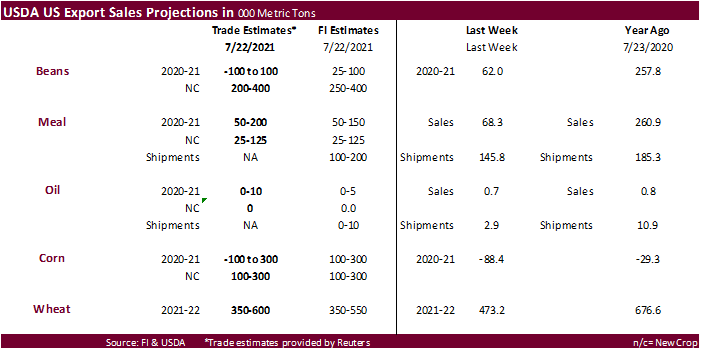
CBOT
First Notice Day delivery estimates by FI
Soybeans
zero (registrations went to zero earlier this week)
Soybean
meal 0-100 (bias zero…175 registered)
Soybean
oil 50-200 (bias light…73 registered out of 388 are “old”)
US
Advance Goods Trade Balance (USD) Jun: -91.2B (est -88.0B; prevR -88.2B; prev -88.1B)
US
Retail Inventories (M/M) Jun: 0.3% (est -0.5%; prev -0.8%)
US
Wholesale Inventories (M/M) Jun P: 0.8% (est 1.1%; prev 1.3%)
Canadian
CPI (Y/Y) Jun: 3.1% (est 3.2%; prev 3.6%)
Canadian
CPI NSA (M/M) Jun: 0.3% (est 0.4%; prev 0.5%)
Canadian
CPI Core–Common (Y/Y) Jun: 1.7% (est 1.9%; prev 1.8%)
Canadian
CPI Core-Median (Y/Y) Jun: 2.4% (est 2.3%; prev 2.4%)
Canadian
CPI Core-Trim (Y/Y) Jun: 2.6% (est 2.6%; prev 2.7%)
US
DoE Crude Oil Inventories (W/W) 23-Jul: -4089K (est -2500K; prev 2107K)
–
Distillate Inventories: -3088K (est -700K; prev -1349K)
–
Cushing Crude Inventories: -1268K (prev -1347K)
–
Gasoline Inventories: -2253K (est -1241K; prev -121K)
–
Refinery Utilization: -0.30% (est 0.40%; prev -0.40%)
74
Counterparties Take $965.189 Bln At Fed’s Fixed-Rate Reverse Repo (prev $927.419 Bln, 71 Bidders)
- Corn
ended higher led by new-crop futures following strength in wheat and chatter China was inquiring about US corn. News was light. US ethanol production fell from the previous week and stocks increased. The September contract settled 0.50 cent higher and new-crop
1.75-3.00 cents higher. September is now only a 0.25 cent premium to December. Back in June this spread peaked around 22.25 cents, September premium. The cause for the gradual collapse between old and new-crop spreads could be in part to slowing US domestic
demand for corn (ethanol and feed use) amid high interior basis levels from tight supplies.
- Funds
bought an estimated net 3,000 corn contracts. - CNGOIC
sees China corn imports on track to reach the target 28 million tons for 2020-21 as they have already imported 20 million tons. This is in part to their forecast for grain feed demand to increase nearly 4 percent from the previous season and a recovery in
the pig crop. Note China has not tendered for US corn since May and this morning we heard they were inquiring for US corn, but nothing materialized as of late Wednesday afternoon. Separately, China’s cabinet announced emergency adjustments of its pork reserves
(likely increasing the volume and frequency of auctions) and take measures to stabilize hog prices (recovery in the pig crop). Domestic pork prices are down sharply month over month.
- South
Africa 2020-21 corn production, updated by the CEC, was estimated at 16.431 million tons, up from 16.233 projected in June and up from the 15.300 million tons last season. It consists of 8.937 million tons of white and 7.494 million tons of yellow. A Reuters
poll called for 16.121 million, about 300,000 below actual. - We
updated our US corn balance sheet. We remain bullish corn exports for remainder of 2020-21 based on strong export inspections, and lowered Q4 (Sep-Aug 2020-21) corn for feed use but that is still above USDA due to minor feed grains diverted to export program
and expensive new-crop Q1 summer domestic wheat. We lifted US corn for ethanol use slightly and remain above USDA. US corn stocks were lowered for old crop, reducing 2021 supplies that keep 2021-22 US ending stocks tight. New crop yield was lowered earlier
this week to 177 due to decline in crop conditions.
EIA
weekly petroleum status report
showed ethanol production last week dropped a more than expected 14,000 barrels to 1.014 million (Bloomberg poll looked for up 3,000) and stocks build of 215,000 barrels to 22.733 (trade up 130k). Stocks are highest since February 19, 2021 and production
lowest since May 7. We think the slowdown in corn crush reflects tighter domestic supplies and high basis, pressuring crush margins. September 2020 through July 23 ethanol production is running 3.3% above the same period a year earlier. Gasoline demand
was up 30,000 barrels to 9.325 million from the previous week, 2.4% below this time two years ago, but ethanol blended into finished motor gasoline fell to 91.5% from 91.7% previous week. Annualized crop year to date ethanol production is still on track to
reach USDA’s implied projection, and corn used for ethanol production is still expected to exceed USDA’s 2020-21 estimate of
5.050 billion bushels (4.852 used during 2019-20). We are above USDA’s estimate at
5.077 billion for 2020-21. For 2021-22 USDA is at 5.200 billion. We are 50 million below USDA’s estimate for new-crop.

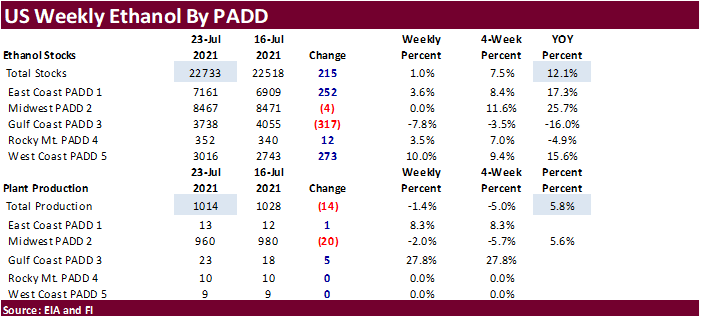
Export
developments.
- 7/28…One
offer: Jordan seeks 120,000 tons of feed barley for Nov/Dec shipment. - Qatar
seeks about 100,000 tons of barley on August 18 for Sep-Nov delivery.
- China
will auction off 202,264 tons of imported US corn and 49,695 tons of imported Ukrainian corn on July 30.
USDA
Attaché: Bangladesh grain and feed update
High
dependency on 2020-21 corn imports from an increase in feed use drove up the local wholesale price for corn. 2021-21 domestic prices are expected to ease from higher domestic production.
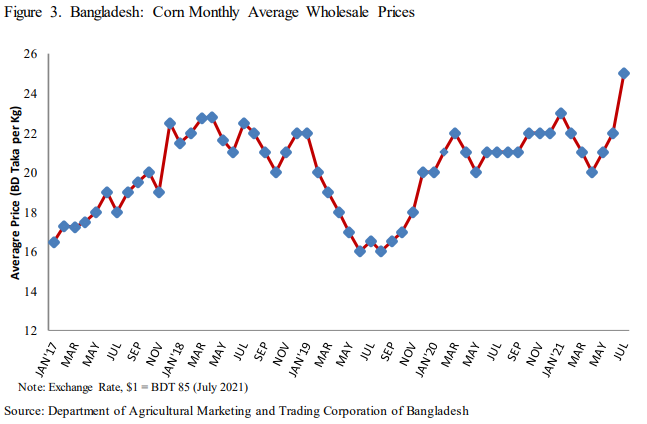
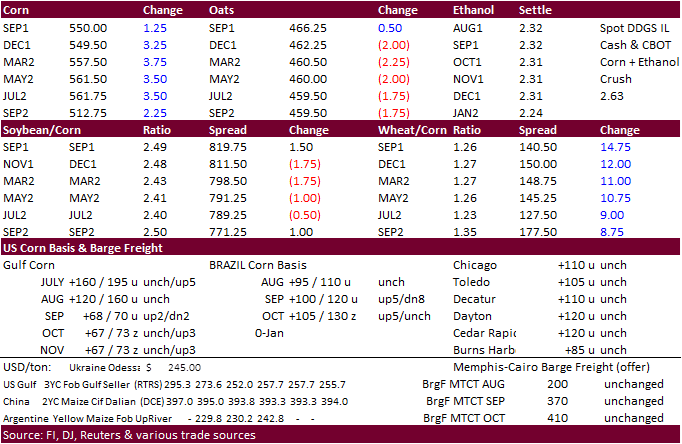
September
corn is seen is a $5.00-$6.25 range
December
corn is seen in a $4.25-$6.00 range.
Soybeans
-
Soybeans
and soybean oil ended higher while meal ended lower. Good demand for domestic soybean oil help lift soybean oil higher. News was light. Traders are waiting for private US crop yield and production estimates, starting with private company surveys Friday
and/or Monday. Thought is both corn and soybean US yields are on track to reach trend.
-
Funds
bought an estimated net 3,000 soybeans, sold 2,000 soybean meal and bought 3,000 soybean oil.
-
Traders
are again looking for low US export sales when updated Thursday morning. -
November
Canadian canola was down 11.40 at $883/ton. Canada’s canola export volume has slowed but crush remains strong.
- CBOT
soybean complex registrations were unchanged. We posted first notice day delivery estimates above the corn comment.
- Indonesia
sets its palm oil reference price for August at $1048.62 per ton, down from $1094.15 in July. Export levies remained unchanged from July.
- The
USDA seeks 2,880 tons of packaged oil for use under the PL480 program on August 3 for Sep 1-30 shipment.
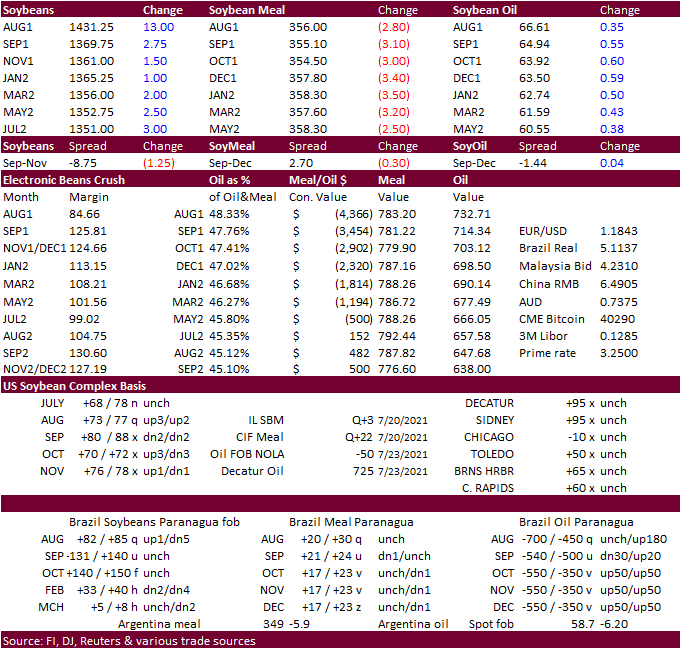
Updated
7/26/21
August
soybeans are seen in a $13.50-$15.00 range; November $11.75-$15.00
August
soybean meal – $330-$400; December $320-$425
August
soybean oil – 64.50-70.00; December 48-67 cent range
- US
wheat ended sharply led by Minneapolis on North American supply concerns. Chicago snapped a four day losing streak. Day 2 early results of the Wheat Quality Council showed Hard red spring wheat yields across six fields in central North Dakota averaged 16
bu per acre. Pictures on Twitter (#wheattour21) looked grim. Some fields were already harvested for hay (wheat abandonment). “Crop scouts estimated yield in this spring #wheat field near Pingree at around 27.5 bushels per acre. Yields further east were in
the 35-45 range,” said Karl Plume https://twitter.com/thekarlplume.
A plot on highway 3 calculated 15 bu/acre. Day 1 US spring wheat crop tour (southern and easter North Dakota) pegged the high protein spring wheat yield at 29.5 bushels per acre, well below a 5-year average of 43.3.
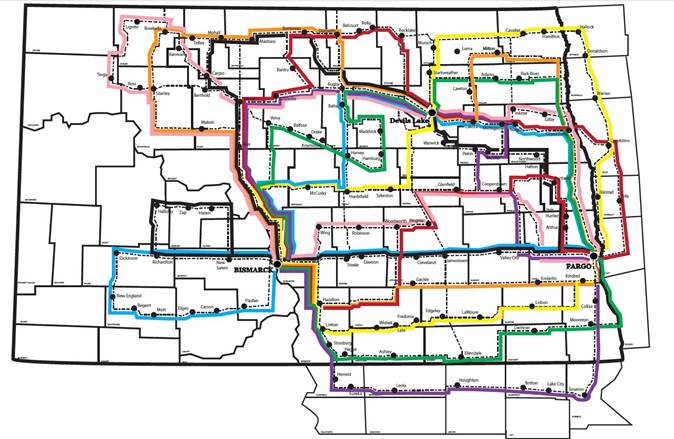
- We
have an upward range target of $9.25 for September MN wheat. It settled at $9.0375 today.
- Funds
bought an estimated net 7,000 SRW wheat contracts. - December
milling wheat closed 3.25 euros or 1.6% higher at 218.25/ton. - Cold
temperatures in Brazil are now thought to be hindering wheat development. Wheat is in mid-season in Brazil. They harvest wheat from October through December.
- Turkey’s
TMO seeks up to around 900,000 tons of 11.5-12.5% milling wheat (395k) and feed barley (515k) for late September 16-30 shipment. The barley is sought on August 3 and wheat on August 4. Turkey is one of Russia’s best customer.
- Results
awaited: Ethiopia seeks 400,000 tons of wheat on July 19.
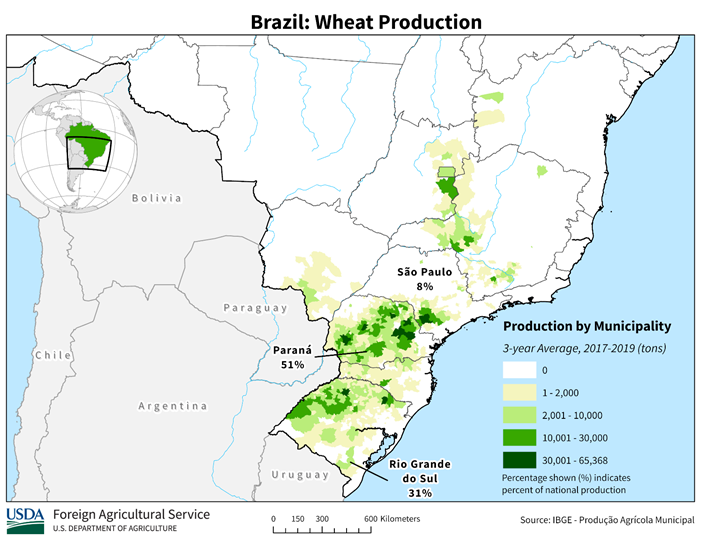
Rice/Other
- There
were 35 rice registration cancelled out of Harrisburg. - Results
awaited: Mauritius seeks 6,000 tons of white rice on July 27 for October through December shipment.
- Brazil:
Major coffee areas in Sao Paulo’s Mogiana, south and southwest of Minas Gerais may face frost on July 30 (Bloomberg)
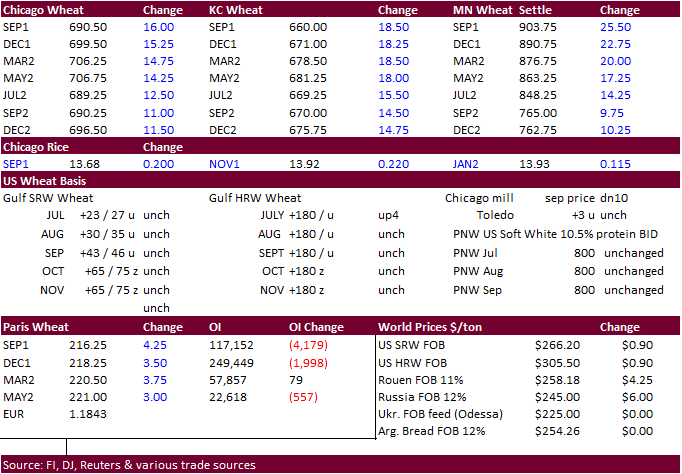
Updated
7/26/21
September Chicago wheat is seen in a $6.25-$7.50 range
September KC wheat is seen in a $5.90-$7.25
September MN wheat is seen in a $8.10-$9.25
Terry Reilly
Senior Commodity Analyst – Grain and Oilseeds
Futures International
One Lincoln Center
18 W 140 Butterfield Rd.
Oakbrook Terrace, Il. 60181
W: 312.604.1366
ICE IM:
treilly1
Skype: fi.treilly

Trading of futures, options, swaps and other derivatives is risky and is not suitable for all persons. All of these investment products are leveraged, and you can lose more than your initial deposit. Each investment product is offered
only to and from jurisdictions where solicitation and sale are lawful, and in accordance with applicable laws and regulations in such jurisdiction. The information provided here should not be relied upon as a substitute for independent research before making
your investment decisions. Futures International, LLC is merely providing this information for your general information and the information does not take into account any particular individual’s investment objectives, financial situation, or needs. All investors
should obtain advice based on their unique situation before making any investment decision. The contents of this communication and any attachments are for informational purposes only and under no circumstances should they be construed as an offer to buy or
sell, or a solicitation to buy or sell any future, option, swap or other derivative. The sources for the information and any opinions in this communication are believed to be reliable, but Futures International, LLC does not warrant or guarantee the accuracy
of such information or opinions. Futures International, LLC and its principals and employees may take positions different from any positions described in this communication. Past results are not necessarily indicative of future results.

